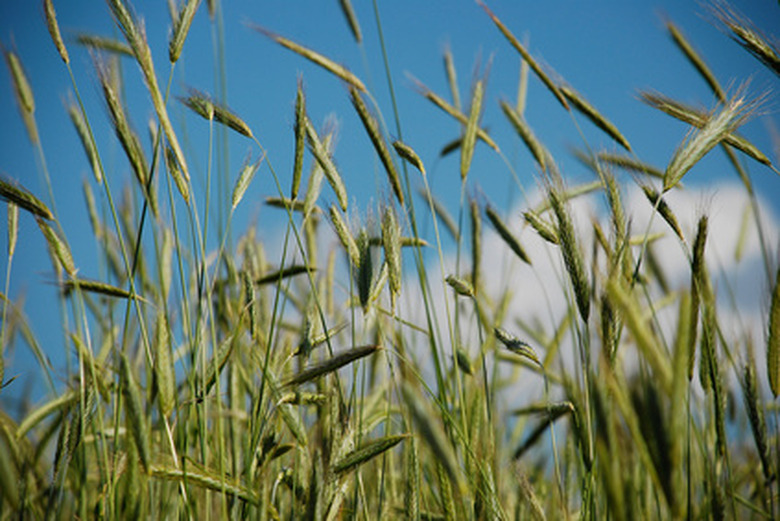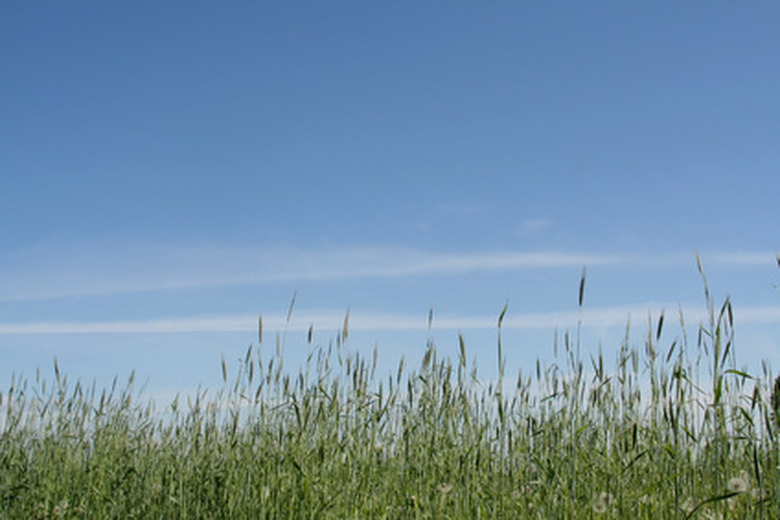Rye Grass
Step 1
Annual ryegrass is a temporary grass used in lawns or as a ground cover. The seeds of annual ryegrass grow so quickly that you can see results in as little as four to five days. If you are using ryegrass in your yard, you will need to know how to maintain it. Part of your maintenance routine should include fertilization. This will keep the ryegrass looking healthy for as long as you need to use it.
Step 1
Choose a fertilizer that is high in nitrogen. According to University of California, Davis, the most important nutrient in the maintenance of ryegrass is nitrogen. A 20-5-10 fertilizer is a good fertilizer for ryegrass.
- Annual ryegrass is a temporary grass used in lawns or as a ground cover.
- A 20-5-10 fertilizer is a good fertilizer for ryegrass.
Step 2
Mix the fertilizer with water at the rate specified on the product label. Not following the product label could give you fertilizer that is not strong enough, or fertilizer that will damage your grass.
Step 3
Apply the fertilizer to your grass. The University of Missouri recommends you apply the fertilizer at a rate of 5 lbs. for every 1,000 square feet of lawn.
Step 4
Apply the fertilizer in September, November and May.
Tip
Mowing your ryegrass frequently is important to its health. You should attempt to keep it at a height of 1 1/2 inches
Warning
Always follow the safety precautions listed on your fertilizer. This may include wearing long clothing and a mask.
Rye grass seed sprouts in soil temperatures of 50 to 65 degrees Fahrenheit and air temperatures 10 degrees higher. Cool-season grasses, both annual and perennial rye grasses perform best in spring and fall and deteriorate in the summer heat.
- Mix the fertilizer with water at the rate specified on the product label.
- Apply the fertilizer in September, November and May.
- Rye grass seed sprouts in soil temperatures of 50 to 65 degrees Fahrenheit and air temperatures 10 degrees higher.
The amount of time needed for grass seed to germinate depends on the type of grass planted. Bluegrass is visible after 20 to 30 days. Bermuda grass sprouts after 10 to 30 days. Rye grass can grow in as little as five days.
The fastest-growing grass seeds are those for annual grasses, such as fescue or rye, which germinate in as little as 10 days.
Annual rye grass is the most commonly used and fastest germinating grass seed. It is used to fill in bare patches and over-seed lawns because it is easy to grow.
- The amount of time needed for grass seed to germinate depends on the type of grass planted.
- The fastest-growing grass seeds are those for annual grasses, such as fescue or rye, which germinate in as little as 10 days.
Step 1
Rinse rye berries and discard rinse water.
Step 2
Combine rye berries, water and sea salt in saucepan.
Step 3
Bring to a boil, then reduce heat. Cover and let simmer for 1 hour.
Step 4
Drain excess water and serve immediately. Top with fresh fruit or brown sugar.
Tip
If you are watching your salt intake, you may omit the sea salt. For a crisper texture, toast the rye berries before cooking. Place rye berries in a dry pan over medium heat. Stir constantly for about four minutes, or until the grains pop and darken. Decrease the cooking time from 1 hour to 20 to 30 minutes by soaking the rye berries overnight.
Warning
Do not eat rye if you are allergic to gluten.
Annual rye grass is a cool season grass that is grown as a lawn or ground cover in winter months. Rye grass seeds should be watered once or twice a day until they germinate, which usually happens in five to seven days.
- Rinse rye berries and discard rinse water.
- Combine rye berries, water and sea salt in saucepan.
Step 1
Remove all old vegetation from the garden area after the first hard frost. Use a rototiller to till the garden area thoroughly. Break up any large clumps of soil, and remove all rocks from the garden site.
Step 2
Level the soil throughout the space with the garden rake.
Step 3
Broadcast the winter rye grass seed over the area at a rate of 3 ounces of seed per 100 square feet of space or 2 pounds per 1000 square feet. Consult your local agricultural extension service, as it may have specific seeding instructions for your area.
Step 4
Water the new seed into the ground, using the garden hose, at least two times during the fall if rainfall is sporadic. The winter rye grass seed should germinate in approximately one week depending on temperatures and sunlight exposure.
- Remove all old vegetation from the garden area after the first hard frost.
- Water the new seed into the ground, using the garden hose, at least two times during the fall if rainfall is sporadic.
Tip
Winter rye grass can be planted from approximately August through October. In most cases, it does well after the first heavy frost that kills off any remaining plants in the garden bed.
Things Needed
- Rototiller
- Garden rake
- Garden hose
Step 1
Mow the ryegrass as low as possible. Wait for it to grow back 3 to 4 inches before treating it. Weeds must be actively growing for most herbicides to work effectively.
Step 2
Spray annual ryegrass with herbicide. According to specialists at Virginia Tech, annual ryegrass responds to applications of 3 pints of Roundup per acre (mixed according to the manufacturer's instructions for the type of sprayer you are using), spaced six weeks apart.
Step 3
Spray perennial ryegrass with a nonselective, post-emergent herbicide that contains glufosinate (Finale) or glyphosate (Roundup). Re-spray at intervals prescribed by the manufacturer. Use a different herbicide in your second application to prevent the ryegrass from developing resistance.
- Mow the ryegrass as low as possible.
- According to specialists at Virginia Tech, annual ryegrass responds to applications of 3 pints of Roundup per acre (mixed according to the manufacturer's instructions for the type of sprayer you are using), spaced six weeks apart.
Tip
Spray weeds on a day with no wind and no rain forecast for the next 48 hours. If you are trying to control perennial ryegrass in your lawn, be careful to spray only the ryegrass with nonselective herbicide, as these chemicals will kill all types of grasses.
Grass seed germinates in 5 to 30 days depending on the type of grass. Rye grass germinates in 3 to 10 days, but Bermuda grass may take 30 days.
Used as a "green manure," fall-growing, annual rye grass planted in late summer sprouts into a dandelion- and weed-chokin-art.html'>choking mat. Kept mowed, this cool-season grass won't self-seed to become invasive. Rye grass dies in winter. Turning the dead grass under replenishes the soil.
Step 1
Prepare lawn in mid-September to mid-October by not watering it for 8 to 10 days.
Step 2
- Grass seed germinates in 5 to 30 days depending on the type of grass.
- Rye grass germinates in 3 to 10 days, but Bermuda grass may take 30 days.
Step 3
Set lawn mower blade to lowest setting.
Step 4
Mow lawn to shortest length, so that rye seed can settle into soil.
Step 5
Spread seed by hand over lawn.
Step 6
Water lawn immediately after spreading seed, preferably in the late afternoon.
Step 7
Mow rye grass and enjoy a blanket of thick green grass.
Step 8
Stop watering grass at the beginning of summer to ensure grass will die out. Water grass again after 10 days to begin your summer grass cycle.
Step 9
- Set lawn mower blade to lowest setting.
- Mow lawn to shortest length, so that rye seed can settle into soil.


